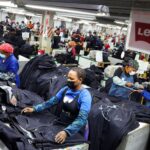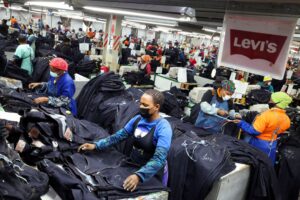CHENNAI, India — It’s back. And with a bang.
It is difficult to meet someone in the world’s second most populous country of 1.35 billion people who has not been touched by the coronavirus pandemic. It’s everywhere.
The pyres of the dead from the virus burn, and people are dying in the streets outside hospitals, as the public health crisis rages on. People cry out for oxygen, and are in dire need of vaccinations to help stop the viral rampage.
We in India watched the second wave of the pandemic sweep over Europe and the Americas, smug in the belief that we had banished it, never to return. Alas, return it did, and with more virulence than before.
“ The pyres of the dead from coronavirus burn, and Indians are dying in the streets outside hospitals, as the virus rages. People cry out for oxygen, and are in dire need of vaccinations. ”
I know of an 80-year-old who has breathing difficulty but has been unable to find a hospital in Chennai. I have been trying to locate a hospital that will accept him, but with little success so far, with every hospital promising to ring back when they have a vacancy.
April has proved the deadliest month for India. Over the last 24 hours, India diagnosed more than 379,257 fresh cases, according to the Ministry of Health and Family Welfare. There were 3,645 new COVID-related deaths.
Coronavirus Update:India’s COVID-19 crisis is a ‘crime against humanity,’ says prize-winning author as nation sets new case record
The total number of COVID-related fatalities here had hit 204,832 as of Thursday, the fourth highest in the world after the U.S., Brazil and Mexico, and the official tally for infections exceeds 18.4 million, second only to the 32.3 million confirmed infections in the U.S.
There is evidence that new variants are tearing through communities. Nearly 60% of new infections in a laboratory test in Maharshtra, India’s second most populous state in the western peninsula, were from variants.
India is grappling with a “double mutant” B.1.617 strain believed to be more transmissible than the original coronavirus. This new variant has two spike proteins instead of one.
This is all a long way from this time last year when the Indian government had declared that it had actually defeated the virus, with commentators marveling at the country’s seemingly miraculous success at keeping SARS-CoV-2 at bay — not that there weren’t skeptics.
In fact, a report in Scientific American magazine said last August that India was “in denial” about the coronavirus pandemic. “The Indian government seems more focused on public relations than enlightened action,” it said, citing the government’s early denial of any community transmission.
“ I know of an 80-year-old, who has breathing difficulty, but has been unable to find a hospital in Chennai. I have been trying to locate a hospital for him, but with little success. ”
To what do we owe this unwanted distinction? Even before the first wave was fully over, normalcy was restored in full (though in stages). Many people gave up all protective protocols — and did not adopt them even during the peak of the pandemic last year. Masks were a thing of the past, and, as for social distancing, the less said, the better.
Adding to our sense of grief and powerlessness: Twitter TWTR, -0.93% confirmed to the BBC that posts critical of our deepening humanitarian crisis have been blocked. “If it is determined to be illegal in a particular jurisdiction, but not in violation of the Twitter Rules, we may withhold access to the content in India only,” the social-media network said in a statement.
“The whole [of] India is petrified, citizens are searching for emergency help, coordinating life support & trying to keep the government accountable, but the [government of India], instead of saving lives, is bringing social media censorship. Condemnable!” Amal Chandra, a writer and activist, wrote on the platform.
We are surrounded by tales of heroism and tragedy. Narayan Dabhalkar, 85, a resident of Nagpur, a city in the western peninsular state of Maharashtra, was admitted to the hospital with falling oxygen levels.
He was so moved by the plight of a 40-year-old critically ill COVID patient who was denied admission that he discharged himself against medical advice, believing he was giving up his bed to the young sufferer. Dabhalkar died at home later, gasping for breath, and yet grateful that he believed he could help someone younger and in need, with a full life ahead of him, according to his family.
“Our entire family is down with COVID,” Dabhalkar’s daughter, Aasawari Kothiwan, was quoted as having told the Times of India. “On April 16, we got his samples tested, and the results came on April 19. The treatment continued at home.”
We may despair at the folly and depravity of human nature during these dark times, but episodes like this restore our faith in the kindness of people and their capacity for self-sacrifice.
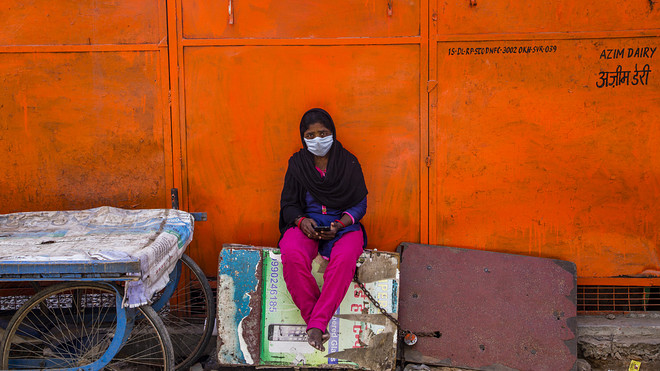
An Indian woman wearing a protective mask plays with her smart phone in a deserted commercial hub in New Delhi.
Yawar Nazir/Getty Images
Election-campaign crowds
What contributed to this surge in infections? Critics point to campaigning, which began last month, for election to the assemblies of the states of Tamil Nadu, West Bengal, Kerala, Assam and Pondicherry.
In India, elections are huge, long-drawn-out festivals. Massive campaign rallies were organized by all major political parties repeatedly as a show of strength, and attendees were packed like sardines in a tin can, many without masks.
Even political campaigning for Prime Minister Narendra Modi went ahead. He attended one such rally this month and declared, “I’ve never seen such huge crowds.”
“ In India, elections are huge, long-drawn-out festivals. Massive campaign rallies were organized by all major political parties repeatedly as a show of strength. ”
This week, Dr. Navjot Dahiya, national vice president of the Indian Medical Association, lashed out at Modi’s rallies, and called the prime minister himself a “superspreader.”
“The scarcity of medical oxygen has become the reason for the death of many patients in every part of the country against the fact that several projects for installing the oxygen are still pending with the union government for clearance, but no heed was given to such an important need by the Modi government,” he said.
If all of this was not enough to invite trouble, the Kumbh Mela, a massive religious event occurring once in 12 years, began at Haridwar at the Himalayan foothills on March 28, 2021. Millions of people bathed in the Ganges and Yamuna rivers at Allahabad on the first day of the festival. “Kumbh Mela, ever since its inception, has always been the biggest and the largest event India has ever witnessed,” the event’s official website states.
Ramadan, a Muslim festival, also took place in April. The government issued strict social-distancing guidelines.
Given all these opportunities for spreading, it is indeed a wonder that things are not much worse.
Holding the Election Commission of India squarely responsible, the Madras High Court has passed unprecedented scathing remarks on the constitutional body, for not having ensured COVID-19 protocols and having allowed political parties to organize massive rallies with utter disregard for the pandemic.
On Tuesday, the Election Commission banned all political victory processions related to the election results on May 2.
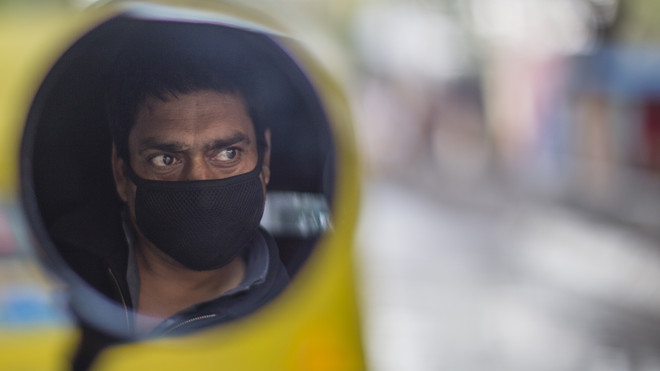
An auto rickshaw driver waits for passengers while wearing a protective mask in Delhi.
Yawar Nazir/Getty Images
Crippling shortage of oxygen
If these are two major factors responsible for the fresh surge, two more pose grave challenges to the containment and treatment efforts.
The first is the crippling shortage of oxygen faced by many states, resulting in critically sick patients, literally gasping for breath. Twenty-five patients lost their lives in a hospital in New Delhi, the capital city, as they could not be administered oxygen.
There is both a bitter irony and tragedy to this country’s oxygen shortage. India exported over 9,000 metric tons of oxygen between April 2020 and January 2021, according to a Ministry of Commerce report.
“ The situation is so bleak that Arvind Kejriwal, chief minister of Delhi, issued a public appeal through newspapers in all parts of the country, seeking oxygen from all those who have it. ”
The government has now ordered oxygen supplies to be diverted from other industries for medical use, but this doesn’t appear adequate. Augmenting oxygen manufacturing capacity in the short term seems difficult.
The situation is so bleak that Arvind Kejriwal, chief minister of Delhi, issued a public appeal through newspapers in all parts of the country, seeking oxygen from all those who have it.
Earlier this week he said that the government would set up 44 new oxygen plants in Delhi within a month.
Trucks carrying oxygen cylinders are being waylaid and looted, in some cases, by relatives of patients, anxious to save the lives of their near and dear, in addition to looters out for a quick buck. Trucks carrying oxygen require a police escort for speedy delivery and, yes, for security.
Such incidents have prompted the Delhi High Court to threaten to hang such looters, treating them on par with murderers. One man traveled 1,400 kilometers by car from Bokara to Noida in about 24 hours, carrying an oxygen cylinder for a friend.
Many hospitals have run out of beds to offer even to the critically ill. This is the dire situation in the capital, and in many metro areas, including Mumbai and Chennai.
Federal, state and local officials may now appear to be expending effort, but there is only so much that can be done in the short term.
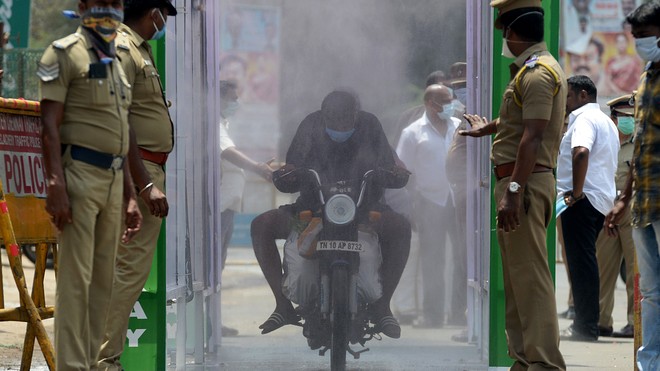
A motorist rides through a disinfection tunnel during in Chennai.
Arun Sankar/AFP via Getty Images
Paltry number vaccinated
Vaccine shortage is another big hurdle in the fight against COVID. Roughly 150 million people have been vaccinated against COVID-19. A paltry 1.8% of the population has been fully vaccinated, with 7.11% having received one shot.
Only 10.5 vaccine doses have been administered per 100 people. That compares with 69.5 doses per 100 people in the United States, according to data aggregated by Our World in Data. (That count comprises all doses administered regardless of whether a shot is a recipient’s first or second, or if the shot is of a single-dose vaccine.)
Last week, people who needed a first or second dose were turned away by both government and private providers, pleading nonavailability. At least a half-dozen states have complained of vaccine shortages.
As soon as the vaccine supplies were ready, India took the lead in shipping 66.37 million doses to 95 countries. This, however, has left India with limited supplies to protect its own citizens, especially at a time of dire need.
“ Last week, people who needed a first or second dose were turned away by both government and private providers, pleading nonavailability. ”
The U.S. is sitting on millions of doses of vaccine, far outstripping its population’s requirement. On Tuesday, the White House said that it will share up to 60 million doses of the AstraZeneca AZN, -1.36% vaccine, not yet authorized for use in the U.S., with other countries as that supply becomes available.
On Monday, the White House said it will provide raw materials for Indian vaccine manufacturers after a “warm and positive” phone call between President Joe Biden and Prime Minister Modi. “The United States is providing a range of emergency assistance, including oxygen-related supplies, vaccine materials, and therapeutics,” the statement read. “Prime Minister Modi expressed appreciation for the strong cooperation between both countries.”
But this action has come as India is mired in a hellish public health crisis that will be difficult to reverse.
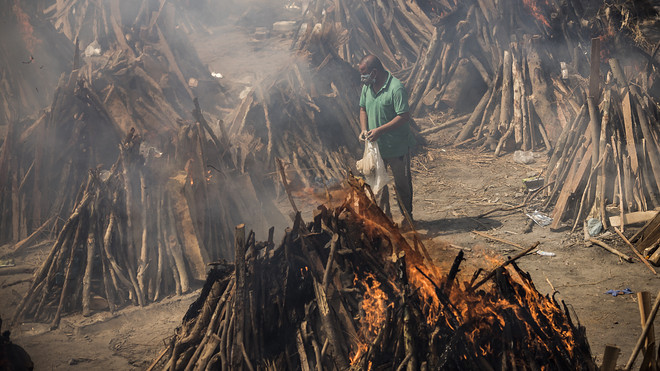
A man performs the last rites of his relative who died of the COVID-19 this month as other funeral pyres are seen burning during a mass cremation at a crematorium in New Delhi.
Anindito Mukherjee/Getty Images
More lockdowns loom
The dark days of hunger and privation experienced during the first wave of the pandemic are still vivid in the memory of Indians. Migrant and domestic workers eke out livings traveling from town to town, and village to village.
With the raging infections, we are slowly inching our way again towards another lockdown. One state after another is announcing it in some form or the other, wary of robbing people of livelihoods while, at the same time, needing to keep people off the streets to prevent spread.
“ The government of Tamil Nadu decided to lock down all places of public worship like temples, churches and mosques, but allowed the state-owned seller of liquor to continue. ”
The severely hit Delhi declared a two-week lockdown this month, and the Maharashtra government followed suit on April 14, while Tamil Nadu has taken tentative steps in imposing a Sunday lockdown, perhaps as a prelude to harsher measures.
This again is proving counterproductive, as people crowd the shops and streets on Saturday, to stock up.
In another irony, the government of Tamil Nadu decided to lock down all places of public worship, whether temple, church or mosque, but allowed the state-owned seller of liquor to continue catering to tipplers at its terribly crowded outlets, with only perfunctory noises about observing protocol.
The government of Tamil Nadu has prohibited public worship at temples from April 26, which means what little income clergy have — across the country, they depend on donations from devotees for their livelihoods — has dried up completely.
Priests, like many workers, had to survive on the munificence of neighbors last year, but this year, most if not all of these generous souls have been impacted by the coronavirus, with attendant medical expenditures.
What keeps the fight and hope alive are the tales of human kindness, extended by total strangers to the needy and helpless, with absolutely no expectation of quid pro quo. In the midst of all the calls for physical distancing, people have come together psychologically in the most extraordinary ways to lend a helping hand.
In Hyderabad, K Venkata Murali, managing director of Kaligotla Technologies, is serving over 5,000 meals daily to the poor through his No Food Waste, an NGO.
S. Gowri, 76, at Perur near Coimbatore in Tamil Nadu, begs near the temple to feed what she gets to 20 street dogs.
She told the Times of India: “My husband was a security officer at a lorry rental office. I worked as a sweeper. We had no children. My brothers, who were more educated, were employed in Tangedco and the agriculture department. After my husband passed away, I didn’t want to become a burden to my brothers’ children and decided to spend my remaining days in the company of God.”
Political recriminations, scapegoating and bureaucratic bungling apart, the governments, both at the federal and the state levels, do now exhibit sincerity in their efforts to save lives and livelihoods; the question however, is whether it is too little, too late.
We live in mortal fear of COVID-19. Every citizen is at risk from these new variants. If he or she is young, a major risk is of having one’s livelihood snatched away, while, if he or she is elderly or sick, it is life itself under threat of being snatched, through no fault of one’s own.
Yet there are still too many on the streets around the world who have yet to learn the lessons of COVID, and go about their business without a mask and don’t maintain social distancing, despite death and disease all around them, and all around the world. When will we and our governments learn?
Sadagopa Iyengar is a writer and editor of the spiritual journal Sri Nrisimhapriya, a retired banker, and the author of eight books on Vaishnavite philosophy. He also teaches Hindu scripture.
This essay is part of a MarketWatch series, Dispatches from a pandemic
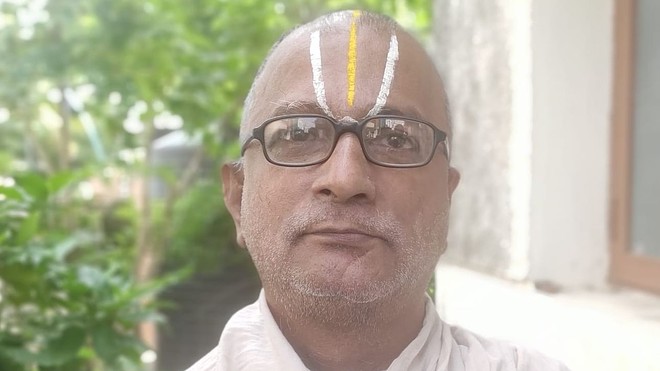
Sadagopa Iyengar: ‘Many people gave up all protective protocols — and did not adopt them even during the peak of the pandemic last year.’
Sadagopa Iyengar


